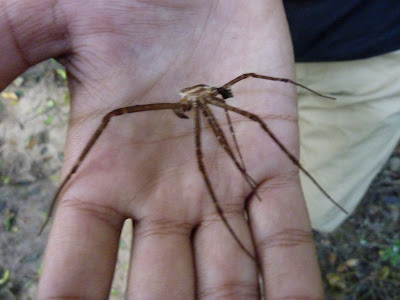The use of feminine charm to lure the "errant" male!
SUNNY SEBASTIAN
Truant T-7 lured by the recorded call of female tigers
The elusive T-7 which was ruling the roost in the Keoladeo National Park (KNP) bird sanctuary near Bharatpur for the past four months has been captured by the wildlife authorities.
The tiger, tranquillised by a team of experts from the Wildlife Institute of India (WII), the Sariska Tiger Reserve and the KNP around 4 p.m. on Wednesday, was taken to Sariska by road an hour later.
Now T-7, a habitual wanderer who left his original home at the Ranthambore National Park for the Kaila Devi Sanctuary in the neighbourhood and later to Dholpur and Mathura in Uttar Pradesh, is heading for Sariska as per the announcement made last month by Union Minister of State for Environment and Forests Jairam Ramesh during a visit to Keoladeo.
Difficult customer
Curiously, T-7, which proved a difficult customer for the experts during the past eight days, was finally caught after it was lured by the recorded call of female tigers. “We have been after the tiger since February 14, but it proved very elusive. Then we thought of trying this technique,” Keoladeo field director Anoop K.R., who was travelling with the caravan headed for Sariska, told The Hindu on Thursday evening.
“We requisitioned recorded calls of the female, and once I received them through e-mail, we played it on Wednesday inside the park at four different places on loudspeakers. To our surprise, the tiger responded and appeared from the thicket of juliflora some 100 metres away,” Mr. Anoop said.
WII's P.K. Malik shot the tranquillising dart and the animal immediately plunged into the thickly wooded area. “It was a great relief to find him unconscious across the road,” Mr. Anoop said.
The team on the spot, which comprised Sariska field director R.S. Shekhawat, forester Narain Singh and researcher Shubheep besides Mr. Anoop and Dr. Mallick, soon transferred T-7 into a wooden cage. The cage has been used earlier to shift big cats —five till date — from Ranthambore to Sariska as part of the now well-known rehabilitation plan for tigers.
Except for one, all other tigers from Ranthambore were airlifted by Air Force helicopters to Sariska. T-7 is the first tiger caught outside Ranthambore to be moved to Sarika, which lost a tiger CP-1, last year.
“Now T-7 will be referred to as ST-6 or CP-6, the sixth tiger to be introduced to Sariska,” said Chief Conservator of Forests (Wildlife) Rajasthan P.S. Somasekhar.
“We may keep the animal in one of the enclosures in Sariska for two or three days before releasing it in the park,” he said. “We hope it soon gets a real call from the three females there.”
A happy ending to this story. Lets hope T7 now to be known as CP6, will thrive in Sariska!




 Coppersmith barbet - Megalaima haemacephala
Coppersmith barbet - Megalaima haemacephala White-breasted kingfisher - Halcyon smyrnensis
White-breasted kingfisher - Halcyon smyrnensis Argiope anasuja. Photo by Junior, with his 35mm Nikon camera and manual focus
Argiope anasuja. Photo by Junior, with his 35mm Nikon camera and manual focus The same argiope, taken by me with the Panasonic Lumix on autofocus. I struggled to get it into focus, as the camera "autofocussed on everything else besides this spider! Reminded me of Dr TPA and the Photography workshop I attended.
The same argiope, taken by me with the Panasonic Lumix on autofocus. I struggled to get it into focus, as the camera "autofocussed on everything else besides this spider! Reminded me of Dr TPA and the Photography workshop I attended. I think this is the Opadometa fastigata, with silver patches across the body
I think this is the Opadometa fastigata, with silver patches across the body Gasteracantha geminata. A common spider of Kerala
Gasteracantha geminata. A common spider of Kerala
 A smiling mum and her baby, all mud bathed
A smiling mum and her baby, all mud bathed To be wild and free
To be wild and free The sad face of a camp elephant. Why do their trunks and ears look so "scrubbed"?
The sad face of a camp elephant. Why do their trunks and ears look so "scrubbed"?
 Those horrible, horrible chains...like prisoners
Those horrible, horrible chains...like prisoners It is no wonder that this elephant in the wild walked off into the forest on seeing us. They cannot possibly view us with ease. Click on the photo and look in the centre you will see an elephant
It is no wonder that this elephant in the wild walked off into the forest on seeing us. They cannot possibly view us with ease. Click on the photo and look in the centre you will see an elephant
 Nice mohawk isn't it?
Nice mohawk isn't it?





